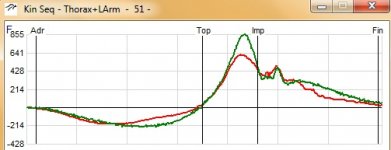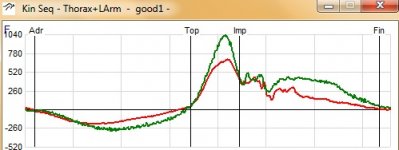Michael Jacobs
Super Moderator
Rummaging through some information to answer a question from a golf pro, I thought I should share some of the Project 1.68 Data Pool that has been collected. For the record, you would have NO SHOT at this info with VIDEO 
So Tug and Tumble
Enjoy and more to come
The interaction between the thorax and the lead arm is a huge part of the swing. The separation stretch that takes place at the lead shoulder is a very brief one and we can see huge differences in this area with varying levels of golfers. Inconsistent ball strikers stretch at the lead arm too long or not at ALL! and their thorax tugs their lead arm down, great strikers have an almost instantaneous stretch and then the lead arm's acceleration rate is very close to the thorax in the early stage of the downswing. Here are 2 graphs that isolate Thorax and Lead Arm. Thorax is Red and Green is Lead Arm. Top is signified by when the club reverses in direction. Note not only the transition and downswing velocities but also their velocities on the backswing.
These are of 2 tour players - One of which was #1 in the world and the other was in the Top 5 in world rankings. These were taken with the 12 sensor 3D system, Kvest has only 3 sensors so the lead arm is not in the data.


So Tug and Tumble
Enjoy and more to come
The interaction between the thorax and the lead arm is a huge part of the swing. The separation stretch that takes place at the lead shoulder is a very brief one and we can see huge differences in this area with varying levels of golfers. Inconsistent ball strikers stretch at the lead arm too long or not at ALL! and their thorax tugs their lead arm down, great strikers have an almost instantaneous stretch and then the lead arm's acceleration rate is very close to the thorax in the early stage of the downswing. Here are 2 graphs that isolate Thorax and Lead Arm. Thorax is Red and Green is Lead Arm. Top is signified by when the club reverses in direction. Note not only the transition and downswing velocities but also their velocities on the backswing.
These are of 2 tour players - One of which was #1 in the world and the other was in the Top 5 in world rankings. These were taken with the 12 sensor 3D system, Kvest has only 3 sensors so the lead arm is not in the data.


Last edited:

